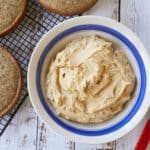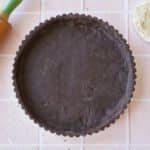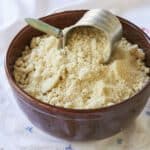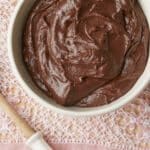
This post may contain affiliate links. Please see my full disclosure for details.
Hi Bold Bakers!
WHY YOU’LL LOVE THIS RECIPE: Learn How to Macerate Fruit, and you’ll transform berries, stone fruit, and more of your favorite produce to their sweetest, juiciest state. Macerate is a long word for a short and easy process that’s a game-changer for fresh fruit! Prep time is just 5 minutes, and all you need is fruit, sugar, and a lemon.
- Macerating improves flavor: Macerating fruit means adding sugar and lemon juice to the fruit and letting it stand. The sugar and lemon juice penetrate the fruit, enhancing its flavor and making it sweeter from the inside out.
- Macerating improves texture: As it sits, the fruit absorbs the lemon juice and sugar, making it juicier and softer. Additionally, the solution breaks down the fruit’s cell walls, making it more tender and succulent. The sugar also draws moisture from the fruit, creating a lovely syrup.
I love introducing Bolder Bakers to simple techniques professional chefs use to create restaurant-level dishes! Taste for yourself how the easy process of macerating fruit elevates desserts like Mixed Berry Shortcake, Lemon Ricotta Pancakes with Macerated Blueberries, Grilled Homemade Shortcake with Strawberries and Lime Cream, Heavenly Meringue Nests with Mango, Strawberry, and Dairy-Free Coconut Cream.
Table of Contents
- What is Macerated Fruit?
- Tools You Need
- Key Ingredients and Why
- How to Macerate Fruit
- Gemma’s Pro Chef Tips
- Can I Macerate Fruit in Advance?
- How to Store Leftover Macerated Fruit
- FAQs
- Recipes Using Macerated Fruit

What is Macerated Fruit?
- Macerated Fruit is fruit mixed with sugar and often an additional liquid, usually a citrus juice like lemon juice. Think of it as a marinade for fruit! Simply add sugar, lemon juice, and zest to the fruit and set it aside. After an hour or two of marinating, the fruit is juicier, sweeter, and more intensely flavored overall.
- Macerated Fruit is an adaptable recipe. Use any fruit you like, and add in other flavors that appeal to you. You can be creative and add anything from whole spices and herbs to citrus, juices, and liqueurs. You’ll find that using a variety of fruit creates a gorgeous blend with a syrupy liquid that’s more than the sum of its parts!
- Macerating fruit was probably originally a preservation technique: fruit picked at harvest time was soaked in a liquid containing alcohol, which allowed it to be stored longer. Today, it’s used in dessert toppings, breakfast accompaniments, sauces, as filling for pies and pastries, compote to top cake or ice cream, and even in side dishes for savory meals.
Tools You Need
Key Ingredients and Why
-
Fruit or berries
- Use a single type of berry, fruit, or a mix of your favorites. If you use a variety, be sure to chop them into similarly-sized bite-size pieces.
- You can even macerate dried fruit, but an overnight soak will be necessary.
-
Granulated sugar
- Granulated sugar draws out the fruit’s juices, softening it and creating a syrup that further enhances its flavor.
- Granulated sugar brings out the fruits’ natural sweetness and enhances tart fruit or fruit that isn’t fully ripe.
- Granulated sugar works perfectly here as it’s readily available, has a clean, sweet taste, and because it’s white, it won’t darken the macerated fruit or syrup.
- You can also use brown sugar, honey, or maple syrup in place of granulated sugar.
-
Lemon
- The citric acid in lemon helps break down and soften the fruit.
- Lemon juice adds a bright flavor note and balances the sweetness of the fruit and granulated sugar.
- Lemon zest adds another layer of citrus and gives the fruit visual and textural interest.
- Use another citrus, like lime or grapefruit, if you prefer!
How to Macerate Fruit
- Wash the fruit and cut into bite-sized pieces if necessary.
- Place the fruit in a bowl and top with sugar, lemon juice, and lemon zest.
- Cover and let sit at room temperature or in the fridge for one to two hours until the sugar has dissolved and the fruit has released some liquid.

Gemma’s Pro Chef Tips
- As with any fruit, using the best, seasonal fruit will always yield the best results, but macerating is also a great way to enhance off-season fruit.
- To add more flavor, you can add two tablespoons of a liquor, liqueur, or vinegar of your choice.
- Ground spices can also be an excellent addition, depending on what you are serving the fruit with.
- Add a vanilla bean to your fruit: split the bean in half, scrape out the seeds, and add the seeds and pod to the macerating fruit. Remove the pod before serving.
- Fresh herbs, grated orange or grapefruit zest, or grated fresh ginger are also wonderful ways to flavor macerated fruit!
- This fruit only keeps for about one day but you can adjust the amount to suit your needs.
Can I Macerate Fruit in Advance?
- It depends on the fruit. Thin-skinned fruits like strawberries will macerate quickly–they will be soft and give off liquid in under an hour, while thicker-skinned fruits like cherries may need an overnight soak.
- In general, once the fruit has soaked it will keep for one day.
How to Store Leftover Macerated Fruit
Store leftover fruit in a covered container in the fridge for one day.
FAQs
-
Can I use frozen fruit?
- To avoid excess liquid, I suggest letting fruits like frozen berries thaw at room temperature.
- Strain the excess water that comes out before adding the sugar and lemon.
-
What are some flavor combinations I can try?
- Blueberries with sugar and lemon
- Banana and pineapple with brown sugar, rum, and lime.
- Cherries with balsamic vinegar, sugar, and vanilla
- Blackberries with lime and mint
- Peaches with brown sugar, lemon, cinnamon, and cardamom.
- Melon with honey, lime, and mint.
-
If I use more than one fruit, how do I make sure they are all equally macerated?
- If you’re making a mix of several types of fruit, you can add them at different intervals.
- Consider the skin of the fruit and its consistency. If you want to make a macerated fruit salad, note that options like grapes or pieces of apple with thicker skins will need a longer soak, but if you add in tender raspberries or blackberries, they won’t need as much time to break down.
More Quick Chef-Secret Recipes
How to Macerate Fruit
Ingredients
- 3 cup (15 oz/426 g) fruit or berries of your choice
- ½ cup (4 oz/115 g) granulated sugar
- Juice and zest of 1 lemon
Instructions
- Wash the fruit and cut if larger than bite-sized pieces.
- Place the fruit in a medium bowl with the sugar and lemon juice and zest.
- Cover and let sit at room temperature or in the refrigerator for 1-2 hours, tossing occasionally, until the sugar has dissolved and the fruit has released some liquid.
- Serve alongside a dessert, or spoon over pancakes, waffles or yogurt.
Recipe Notes
- As with any fruit, using the best, seasonal fruit will always yield the best results, but macerating is also a great way to enhance off-season fruit.
- To add more flavor, you can add two tablespoons of a liquor, liqueur, or vinegar of your choice.
- Ground spices can also be an excellent addition, depending on what you are serving the fruit with.
- Add a vanilla bean to your fruit: split the bean in half, scrape out the seeds, and add the seeds and pod to the macerating fruit. Remove the pod before serving.
- Fresh herbs, grated orange or grapefruit zest, or grated fresh ginger are also wonderful ways to flavor macerated fruit!
- This fruit only keeps for about one day but you can adjust the amount to suit your needs.







Gemma,
Macerating works great for jams. I’ve only recently learned this method and word :). I’ve really been enjoying making peach jam. Macerate the cut up peaches with skin for hours then cook to jell without pectin. Yum!